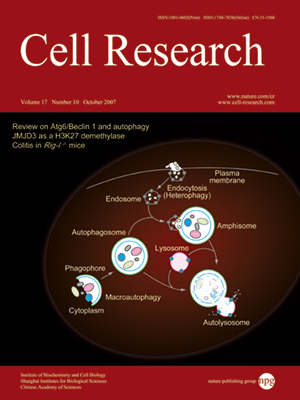
Volume 17, No 10, Oct 2007
ISSN: 1001-0602
EISSN: 1748-7838 2018
impact factor 17.848*
(Clarivate Analytics, 2019)
Volume 17 Issue 10, October 2007: 839-849
REVIEWS
Physiological functions of Atg6/Beclin 1: a unique autophagy-related protein
Yang Cao and Daniel J Klionsky
Departments of Molecular, Cellular and Developmental Biology and of Biological Chemistry, Life Sciences Institute, University of Michigan, Ann Arbor, Michigan 48109-2216, USA
Correspondence: Daniel J Klionsky(klionsky@umich.edu)
The most striking morphological feature of eukaryotic cells is the presence of various membrane-enclosed compartments. These compartments, including organelles and transient transport intermediates, are not static. Rather, dynamic exchange of proteins and membrane is needed to maintain cellular homeostasis. One of the most dramatic examples of membrane mobilization is seen during the process of macroautophagy. Macroautophagy is the primary cellular pathway for degradation of long-lived proteins and organelles. In response to environmental cues, such as starvation or other types of stress, the cell produces a unique membrane structure, the phagophore. The phagophore sequesters cytoplasm as it forms a double-membrane cytosolic vesicle, an autophagosome. Upon completion, the autophagosome fuses with a lysosome or a vacuole in yeast, which delivers hydrolases that break down the inner autophagosome membrane along with its cargo, and the resulting macromolecules are released back into the cytosol for reuse. Autophagy is therefore a recycling process, allowing cells to survive periods of nutrient limitation; however, it has a wider physiological role, participating in development and aging, and also in protection against pathogen invasion, cancer and certain neurodegenerative diseases. In many cases, the role of autophagy is identified through studies of an autophagy-related protein, Atg6/Beclin 1. This protein is part of a lipid kinase complex, and recent studies suggest that it plays a central role in coordinating the cytoprotective function of autophagy and in opposing the cellular death process of apoptosis. Here, we summarize our current knowledge of Atg6/Beclin 1 in different model organisms and its unique function in the cell.
Cell Research (2007) 17:839-849. doi: 10.1038/cr.2007.78; published online 25 September 2007
FULL TEXT | PDF
Browse 1784


